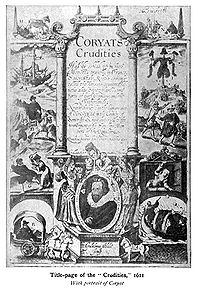- Coryat's Crudities
-
Coryat's Crudities: Hastily gobled up in Five Moneth's Travels is a travelogue published in 1611 by Thomas Coryat of Odcombe, an English traveller and mild eccentric.
Contents
History
The book is an account of a journey undertaken, much of it on foot, in 1608 through France, Italy, Germany, and other European countries by Thomas Coryat of Odcombe. Among other things, it introduced the use of the fork to England[1] and, in its support of continental travel, helped to popularize the idea of the Grand Tour that rose in popularity later in the century. It represents a contemporary account of the music of Giovanni Gabrieli performed in the Scuola di San Rocco. It was likely the earliest English rendering of the legend of William Tell. It was only twice reprinted before modern facsimiles (1776 & 1905, those including the later trip to Persia & India, where Coryat died), and the first edition is quite rare today.
Coryat (sometimes also spelled "Coryate" or "Coriat") conceived of the 1,975-mile (3,175 km) voyage to Venice and back in order to write the subsequent travelogue dedicated to Henry, Prince of Wales, at whose court he was regarded as somewhat of a buffoon and jester, rather than the wit and intellectual he considered himself. The extent to which Coryat invited such ridicule in pursuit of patronage and court favor is unclear.[2] The title, however, implies the use of crudity related to "imperfectly digested" or "indigestible" (Oxford English Dictionary).
"Commendatory" verses
A custom of Renaissance humanists was to contribute commendatory verses that would preface the works of their friends. In the case of this book, a playful inversion of this habit led to a poetic collection that firstly refused to take the author seriously; and then took on a life of its own. Prince Henry as Coryat's patron controlled the situation; and willy-nilly Coryat had to accept the publication with his book of some crudely or ingeniously false panegyrics. Further, the book was loaded with another work, Henry Peacham's Sights and Exhibitions of England, complete with a description of a perpetual motion machine by Cornelis Drebbel.[3]
Coryat, therefore, was jokingly mocked by a panel of contemporary wits and poets of his acquaintance. At the behest of the teenage prince, a series of verses was commissioned, of which 55 were finally included for publication. The authors of these verses, which included John Donne, Ben Jonson, Inigo Jones, and Sir Thomas Roe, among others, took especial liberties with personal anecdotes, finding Coryat's self-importance a ripe source of humour. The literary men known to Coryate were typically courtiers, or those whom he had met through Edward Phelips of the Middle Temple, a patron from Somerset.[4] A full list of the authors (translated from Latin originals) is given in the margin in a 1905 edition.[5]
Ἀποδημουντόφιλoς [Greek pseudonym]
Henry Nevill
John Harrington
Ludovic Lewknor
Henry Goodier
John Payton junior
Henry Poole
Robert Phillips
Dudley Digges
Rowland Cotton
Robert Yaxley
John Strangwayes
William Clavel
John Scory
John Donne
Richard Martin
Laurence Whitaker
Hugo Holland
Robert Richmond
Walter QuinChristopher Brooke
John Hoskins
John Pawlet
Lionel Cranfield
John Sutclin
Inigo Jones
George Sydenham
Robert Halswell
John Gyfford
Richard Corbet
John Dones
John Chapman
Thomas Campian
William Fenton
John Owen
Peter Alley
Samuel Page
Thomas Momford
Thomas BastardWilliam Baker
Tὸ Ὀρὸς-ὀξὺ [Greek pseudonym]
Josias Clarke
Thomas Farnaby
William Austin
Glareanus Vadianus
John Jackson
Michael Drayton
Nicholas Smith
Laurence Emley
George Griffin
John Davis
Richard Badley
Jean Loiseau de Tourval
Henry Peacham
James Field
Glareanus Vadianus
Richard Hughes
Thomas CoryatThere were poems in seven languages. Donne wrote in an English/French/Italian/Latin/Spanish macaronic language. Peacham's was in what he called "Utopian", which was partly gibberish, and the pseudonymous Glareanus Vadianus (tentatively John Sanford) wrote something close to literary nonsense. The contribution of John Hoskyns is called by Noel Malcolm "the first specimen of full-blown literary English nonsense poetry in the seventeenth century".[6]
Coryat had to take this all in good part. The book appeared with engravings by William Hole, and the author received a pension.[7] Shortly a pirate version of the verses appeared, published by Thomas Thorpe, under the title The Odcombian Banquet (1611).[8]
Modern analogues
British travel writer and humourist Tim Moore retraced the steps of Coryat's tour of Europe, as recounted in his book Continental Drifter.
References
- Malcolm, Noel (1997), The Origins of English Nonsense
- Strong, Roy (2000), Henry Prince of Wales and England's Lost Renaissance
Notes
- ^ Michael Strachan, "Coryate, Thomas (c. 1577-1617)", in Literature of Travel and Exploration: an Encyclopedia, 2003, Volume 1, pp.285-87
- ^ R.E. Pritchard, Odd Tom Coryate, The English Marco Polo. Thrupp, Stroud, Gloucestershire: Sutton, 2004. 154-5.
- ^ Strong, p. 162.
- ^ Malcolm, p. 13.
- ^ http://www.archive.org/stream/coryatscrudities01coryuoft#page/n53/mode/2up
- ^ Malcolm, p. 13.
- ^ Strong, p. 24.
- ^ Kathman, David, "Thorpe, Thomas", on the website of the Oxford Dictionary of National Biography (Subscription or UK public library membership required), http://dx.doi.org/10.1093/ref:odnb/27385
Further reading
- Chaney, Edward, "Thomas Coryate", entry in the Grove-Macmillan Dictionary of Art.
- Chaney, Edward (2000). "The Evolution of the Grand Tour: Anglo-Italian Cultural Relations since the Renaissance." 2nd ed. Routledge: London and New York.
- Craik, Katharine A. (2004). "Reading Coryats Crudities (1611)." Studies in English Literature 1500-1900 44(1): 77-96.
- Penrose, Boies. (1942). Urbane travelers: 1591-1635. Philadelphia: University of Pennsylvania Press.
- Pritchard, R.E. (2004). Odd Tom Coryate, The English Marco Polo. Thrupp, Stroud, Gloucestershire: Sutton.
- Strachan, Michael. (1962). The life and adventures of Thomas Coryate. London: Oxford University Press.
External links
Categories:- Travel books
- 1611 books
Wikimedia Foundation. 2010.

